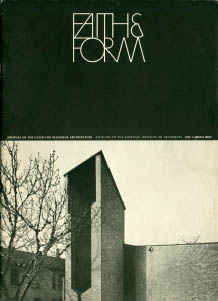
Volume One of Faith & Form magazine, 1967.
A whole new world opened up… a world where people were doing interior design, historic preservation, and ecclesiastical design.”
Bishop Jennifer Baskerville-Burrows, who we interview in the Summer 2020 issue of Sacred Places, was recalling her participation in a national conference sponsored by an organization that was new to her: the Interfaith Forum on Religion, Art and Architecture (IFRAA). That conference in the late 1980s helped to shape, we learn in our interview, the perspective she has brought to her leadership in the church ever since.
Here at Partners, we can tell a similar story. IFRAA published a beautifully designed, full-color quarterly magazine, Faith & Form, which was one of the first publications we secured when we organized our information clearinghouse in 1989. Although other newsletters and humbler periodicals emerged to address sacred places in later years, for a very long time Faith & Form (F&F) was without equal in reflecting and addressing sacred places in America.
In recent years, Faith & Form operated as an independent entity, but it has now merged with Sacred Places, after much planning and good conversation between Partners and F&F’s leadership. All of us here at Partners are honored to continue and build on Faith & Form’s legacy. Although this magazine cannot accommodate the full range of content that Faith & Form has addressed all those years, we will do our best to continue its work, and have created a section in our magazine issue to continue this focus. Moreover, we are privileged to work with Michael J. Crosbie—Faith & Form’s long-time editor—to help us manage the editorial content of Sacred Places magazine publication in the years to come.
We believe that Sacred Places’ traditional focus on how to care for and maximize the larger value of older religious buildings is a perfect complement to Faith & Form’s focus on the design of both historic and contemporary sacred art and architecture. Of course we have always cared deeply about the architecture and artisanry of our great churches, synagogues and other places of faith, and, correspondingly, Faith & Form has always cared about the function and purpose of sacred design. In more recent years F&F has given more attention to how sacred places can be shared and reconfigured to serve their communities in important ways, and has asked Partners to provide articles and essays for publication. And we, in turn, have tried to keep an eye on the architecture and design of the buildings we serve, such as a recent article we published on Louis Sullivan’s masterful St. Paul’s United Methodist Church in Cedar Rapids, Iowa.
So, you might say we have been moving closer together over the last few years, and this issue is the culmination.
The summer 2020 issue is also special in another way: For the first time in our history, a current event—that is, COVID 19—has fundamentally changed so much of the work and worship of faith communities overnight, with enormous implications for how congregations might use their buildings and other assets in the future. Yes, worship services and outreach programs were dislocated and are slowly coming back, but many changes may last for months or years. Congregations may lose members, or gain them, may host a larger worshipping congregation or a smaller one, and will certainly host ministries in new ways.
However, the world around the church or synagogue has changed too, which will pose challenges as well as opportunities. Certainly community needs and human suffering will be greater than ever, and many of the programs that serve the arts and human services may need new spaces, new partners and new resources in this new era. Sacred places—carefully opened and thoughtfully managed—may be able to provide those spaces and resources.
Thus, it is likely that our religious properties will assume a greater civic value than ever before. All the more reason for Partners to proceed with its work, powerfully and imaginatively, in the months and years to come.
